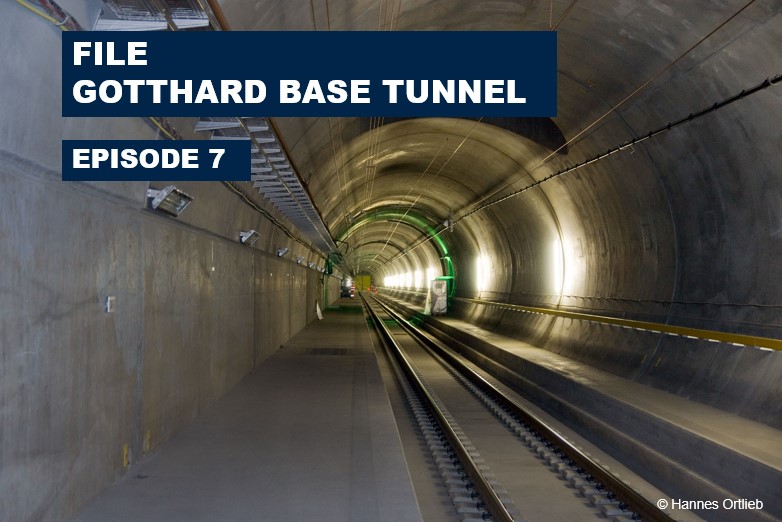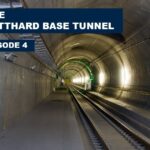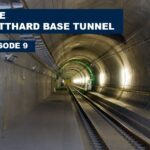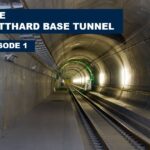On 28 September 2023, the Swiss Safety Investigation Authority (Sust) published its interim report on the derailment of the freight train in the Gotthard Base Tunnel. It documents the course of the accident and makes initial safety recommendations. The event is now being processed by the responsible international committees. Both the European railway industry and Switzerland are represented here. The report should not be misused for a national solo action.
This is what it’s all about:
- Fatigue cracks caused wheel breakage
- Further investigation is well coordinated
- Consequential initial safety recommendations
- Accident clarified – but not yet completely solved
Fatigue cracks caused wheel breakage
Fortunately, Sust submitted its interim report very quickly. In it, it identifies the broken wheel disc of the eleventh freight wagon as the cause of the derailment in the Gotthard Base Tunnel. The wagon is registered in Sweden. The damaged wheel is wheel type BA 390 with LL brake pads. All the fractured surfaces show fatigue cracks originating from the tread. They are now the subject of in-depth metallographic examinations by Sust. The Sust report contains no evidence of pre-existing operational defects that could have caused derailment.
Further investigation is well coordinated
The incident is now being dealt with by the Joint Network Secretariat (JNS). The aim of this body is an EU-wide harmonisation of all measures taken after an accident or incident in European rail transport. The JNS supports the European Railway Agency (ERA) in organising the exchange of experience between national supervisory and investigative authorities and the industry organisations accredited by ERA. The latter also include the three players in the triangle of responsibility for rail transport: the infrastructure manager (responsible for the infrastructure), the wagon keeper (responsible for the maintenance of the wagons) and the freight railway undertaking (responsible for the operation of the wagons). At the same time, Sust triggers a so-called Safety Alert in the SIS information system, which is used by the national supervisory and investigative authorities. And finally, the Swedish wagon keeper deposits a warning message in ERA’s Safety Alert IT Tool (SAIT).
Based on these notifications and as part of the coordinated process, all European stakeholders should have access to the published information. It is now up to them to draw the right conclusions in the exchange between national authorities, industry representatives and ERA. Thanks to the Land Transport Agreement, Sust is recognised by ERA as an investigative body, as is the Federal Office of Transport (FOT) as a safety authority. The matter is now being dealt with by the competent international bodies. We consider this fact to be entirely correct and necessary in view of the cross-border use of freight wagons throughout Europe. The responsible bodies will next establish a reference to similar wheel breakages from the past.
Consequent first safety recommendations
The Sust report makes two short-term safety recommendations, which the VAP supports without reservation. In Recommendation No. 183, it advocates that the FOT extend the 2017 “JNS Urgent Procedure Broken Wheels” to the BA 390 series wheelsets. The “JNS Task Force Broken Wheels” set up at that time had reacted to several wheel fractures on the BA 314 and BA 004 wheel types and called for more intensive inspections in operation and maintenance to limit the risks for these wheel types. We also welcome Safety Recommendation No. 184, in which Sust urges the FOT to apply for a new “JNS Procedure” at European level to deal with the wheel breakage on the BA 390 series. This should prevent further similar wheel breakages from occurring.
Accident clarified – but not yet completely solved
The interim report corrects the misleading media coverage of the accident, according to which the derailed wagon 11 also damaged the safety gate to the east tunnel, which weighed about 100 tonnes. According to Sust, it was not until carriage 14 hit the switch track at the Faido multifunction station switch that it struck the safety gate. Further investigations are necessary to fully clarify the accident in detail. This includes, for example, analyses of the wagon 14 and the switch. Sust will only provide a complete clarification of the course of events and causes of the accident in its final report. Once this has been published, it is the responsibility of all actors involved in the JNS procedures to draw the right conclusions from it for competitive and safe European rail transport. The recommendations of the Sust final report will be implemented by the entire industry.



